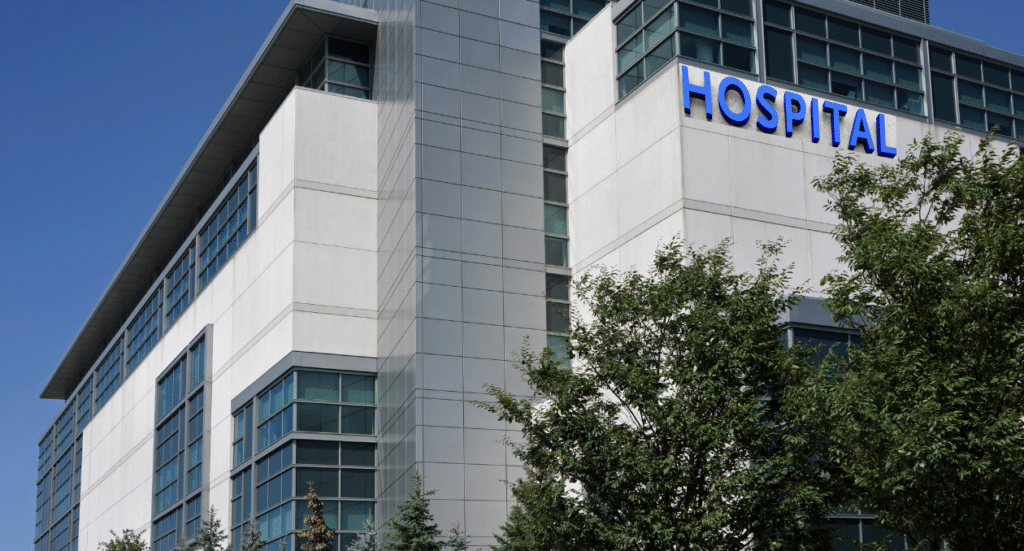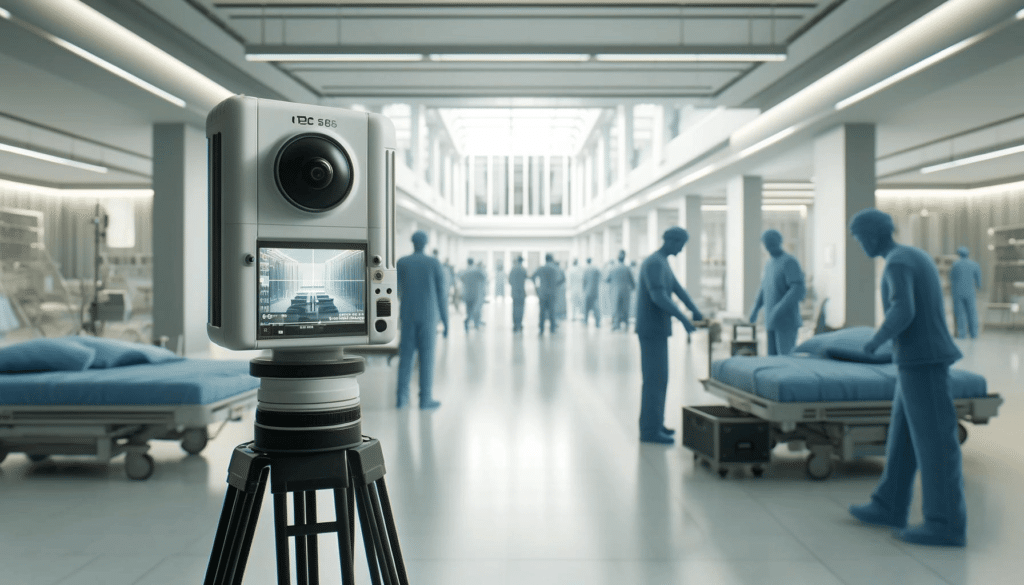The role of 3D Laser Scanning in Modern Healthcare Construction & Renovation
In the dynamic realm of healthcare construction and renovations, where precision, efficiency, and uninterrupted patient care are of utmost importance, safety and seamless coordination become non-negotiable.
Enter 3D laser scanning—a revolutionary technology that not only streamlines hospital construction and renovations but also offers numerous advantages in navigating the intricate landscape of modern healthcare environments. 3D laser scanning is reshaping how contractors approach complex projects.
In this article, let us explore the significance of 3D laser scanning in hospital upgrades, emphasizing its role in the construction workflow while ensuring uninterrupted operations and delivering outstanding results.

Navigating the Complexity of Healthcare Renovation
Embarking on hospital renovations demands meticulous planning and coordination, especially when the facility must remain operational throughout the process. Integrating 3D laser scanning requires a thorough understanding of the unique challenges posed by healthcare environments. Let us take a closer look at some of these challenges.
- CONTAINING HAZARDOUS MATERIALS
In older hospital facilities, the presence of asbestos above the ceilings can pose additional challenges. This requires the use of contamination carts. Additionally, it is vital to exercise utmost caution when displacing ceiling tiles and factor in the delays caused when scanning these areas due to asbestos abatement.
- CAPTURING THE COMPLEXITY OF MEP
The density of Mechanical, Electrical, Plumbing, and Fire Protection (MEPFP) systems in hospitals is incredibly high. It requires capturing every intricate detail with the required accuracy. 3D laser scanning can provide a comprehensive overview of these complex systems to facilitate informed decision-making during renovations.
- STAKEHOLDER COORDINATION FOR OPTIMAL OPERATIONS
Patient care with minimal disruption is a priority. This requires seamless coordination between the nursing staff and facility management teams. Therefore, we need a qualified, experienced Laser scanner provider who has effective communication and collaboration with the healthcare team.
At times, scanning outside of regular business hours can prove beneficial in minimizing disruptions to hospital operations. Through strategic scheduling, construction, and surveying teams can optimize the time required for scanning and accomplish tasks without impacting critical hospital operations.
- PROTECTING PATIENT PRIVACY
Hospital environments store extremely sensitive patient records and confidential information. Before scanning, it is imperative to safeguard all patient information to ensure no unintended capture. 3D laser scanning providers implement strict measures to protect patients’ privacy throughout the scanning process.
Additionally, scanning emergency rooms presents unique challenges due to their heavy footfall, constant activity, and complex layouts. Scanning emergency rooms requires the use of specialized strategies for accurate data collection with little to no disruption to emergency services.

Tapping into the benefits of 3D Laser Scanning in Hospital Renovations
Beyond addressing the logistical complexities of healthcare construction discussed above, 3D laser scanning offers many advantages that propel hospital renovation technology into the digital age. Let us look at some reasons why 3D laser scanning is emerging as an invaluable asset.
- Precision and Acurracy Redefined
As healthcare facilities strive to modernize and expand to meet growing demands, the role of 3D laser scanning becomes a game-changer.
3D laser scanning captures detailed measurements of existing structures to create as-built data with unmatched precision. This groundbreaking tool can minimize errors and discrepancies and ensure that renovations proceed smoothly and according to plan.
Whether it is mapping out floor plans, assessing structural integrity, or analyzing spatial constraints, 3D laser scanning provides a comprehensive understanding of the existing infrastructure, laying the foundation for a successful renovation project.
Through 3D laser scanning, hospitals can overcome the inherent challenges of construction and achieve greater collaboration with improved efficiency and accuracy.
- Enhanced Safety Measures
The safety of everyone is paramount in healthcare operations, whether it is the hospital staff, patients, or visitors. Traditional renovation methods pose several risks, such as manual measurement errors and hazardous working conditions. However, 3D laser scanning can address these challenges by enabling remote data collection in hazardous or hard-to-reach areas and minimizing the need for personnel to be present on-site.
Furthermore, the comprehensive data captured through 3D laser scanning allows construction teams to proactively identify potential safety hazards and ensure a secure working environment throughout the renovation process and compliance with stringent regulatory standards.
- Optimize Efficiency with Digital Construction
Time is of the essence in hospital renovations, as any delay can impact patient care and day-to-day operations. Traditional surveying and documentation methods are time-consuming and labor-intensive, often leading to project delays and increased costs.
3D laser scanning can streamline the data collection process by significantly reducing the time required for site assessment and measurement. By capturing millions of data points in a matter of minutes, 3D laser scanning fast-tracks the construction workflow by digitizing the entire process.
From initial surveys to as-built documentation, 3D laser scanning streamlines the healthcare renovation process and enables construction teams to proceed with confidence, completing renovations on schedule and within budget.
Further, by overlaying scanned data with proposed design plans, 3D laser scanning can identify clashes and conflicts early in the project lifecycle. This proactive approach helps minimize rework and ensures a smooth construction process. This enhanced visualization can also facilitate informed decision-making among stakeholders, such as architects, contractors, MEP consultants, and facility managers, to collaborate more effectively to achieve better outcomes.
- Cost-effective Solution for Future-proofing hospital infrastructure
The as-built documentation produced by 3D laser scanning can serve as a valuable resource not just for ongoing maintenance but also for laying the foundation by providing a comprehensive digital record of the building’s structure and systems for future planning and expansion. By eliminating rework, minimizing errors, and optimizing resource allocation, 3D laser scanning ultimately leads to significant cost savings over a renovation project.
Moreover, the enhanced precision and efficiency offered by 3D laser scanning translates into shorter project timelines, reducing labor costs and minimizing disruptions to hospital operations. As hospitals aim to deliver quality care within budgetary constraints, 3D laser scanning emerges as a cost-effective solution, delivering measurable returns on investment.
In conclusion
Innovation is the key to success in the rapidly evolving landscape of healthcare construction. By embracing the power of 3D laser scanning, hospitals can navigate the complexities of renovations with confidence and precision. From streamlining workflows to enhancing collaboration and ensuring compliance, this transformative technology unlocks a world of possibilities for healthcare facilities striving to deliver the highest standard of care.
As the demands of modern healthcare continue to grow, so does the importance of welcoming digital construction technologies like 3D laser scanning. By harnessing data-driven insights and streamlining construction, hospitals can meet today’s needs and prepare for tomorrow’s challenges. With 3D laser scanning as a cornerstone of their construction workflow, healthcare facilities can embark on renovations with confidence and minimal disruption, equipped with the tools and technology to succeed and meet the ever-changing needs of patients and practitioners alike.